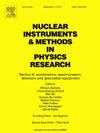Analytic derivation of the multiplicity moments in Active Neutron Coincidence Counting with a non-Poissonian interrogation source
IF 1.5
3区 物理与天体物理
Q3 INSTRUMENTS & INSTRUMENTATION
Nuclear Instruments & Methods in Physics Research Section A-accelerators Spectrometers Detectors and Associated Equipment
Pub Date : 2025-04-02
DOI:10.1016/j.nima.2025.170469
引用次数: 0
Abstract
Active Neutron Multiplicity Counting (ANMC) methods utilize an inversion formula to extract the intensity of a fission source. This is achieved by analyzing the sampled moments of the count distribution, which are generated through the process of inducing fissions in the sample using an external interrogation source. ANMC serves as a powerful tool for quantifying fissile mass e.g., for uranium quantification in mines, fuel fabrication facilities, and reprocessing plants. Typical ANMC methods employ Poissonian interrogation neutron sources, such as AmLi, which emit a single neutron at each source event.
In this study, we expand upon the conventional formulas used in ANMC inversion to accommodate non-Poissonian interrogation sources. Specifically, we derive analytical expressions for the rates of Singles and Doubles events in ANMC systems. This advancement holds practical significance as it enables the future implementation of ANMC methods utilizing external sources with correlated neutrons, such as AmBe or 252Cf.
Aligned with established formulas, the derived formulas in this study adhere to the single-group model and incorporate the influence of fission chains through the widely recognized Bohnel method.
非泊松讯问源中子符合计数中多重矩的解析推导
有源中子多重计数(ANMC)方法利用一个反演公式来提取裂变源的强度。这是通过分析计数分布的采样矩来实现的,这些采样矩是通过使用外部询问源在样品中诱导裂变的过程产生的。ANMC是量化可裂变物质的有力工具,例如用于矿山、燃料制造设施和后处理工厂的铀量化。典型的ANMC方法采用泊松探测中子源,如AmLi,在每个源事件中发射一个中子。在这项研究中,我们扩展了在ANMC反演中使用的常规公式,以适应非泊松讯问源。具体地说,我们导出了ANMC系统中单打和双打事件速率的解析表达式。这一进展具有实际意义,因为它使未来能够利用具有相关中子的外部源(如AmBe或252Cf)实现ANMC方法。与已建立的公式一致,本研究的推导公式坚持单群模型,并通过公认的Bohnel方法纳入裂变链的影响。
本文章由计算机程序翻译,如有差异,请以英文原文为准。
求助全文
约1分钟内获得全文
求助全文
来源期刊
CiteScore
3.20
自引率
21.40%
发文量
787
审稿时长
1 months
期刊介绍:
Section A of Nuclear Instruments and Methods in Physics Research publishes papers on design, manufacturing and performance of scientific instruments with an emphasis on large scale facilities. This includes the development of particle accelerators, ion sources, beam transport systems and target arrangements as well as the use of secondary phenomena such as synchrotron radiation and free electron lasers. It also includes all types of instrumentation for the detection and spectrometry of radiations from high energy processes and nuclear decays, as well as instrumentation for experiments at nuclear reactors. Specialized electronics for nuclear and other types of spectrometry as well as computerization of measurements and control systems in this area also find their place in the A section.
Theoretical as well as experimental papers are accepted.

 求助内容:
求助内容: 应助结果提醒方式:
应助结果提醒方式:


